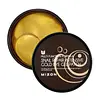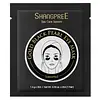What's inside
What's inside
 Key Ingredients
Key Ingredients

 Benefits
Benefits

 Concerns
Concerns

 Ingredients Side-by-side
Ingredients Side-by-side

Water
Skin ConditioningGlycerin
HumectantCalcium Chloride
AstringentCeratonia Siliqua Gum
EmollientXanthan Gum
EmulsifyingNiacinamide
SmoothingDipropylene Glycol
HumectantMethylpropanediol
SolventSnail Secretion Filtrate
Skin Conditioning1,2-Hexanediol
Skin ConditioningPentylene Glycol
Skin ConditioningCitrus Grandis Seed Extract
AstringentBambusa Textilis Stem Extract
Skin ConditioningPinus Palustris Leaf Extract
TonicChondrus Crispus Powder
AbrasiveHydrolyzed Collagen
EmollientPEG-60 Hydrogenated Castor Oil
EmulsifyingEthylhexylglycerin
Skin ConditioningPhellinus Linteus Extract
Skin ConditioningInonotus Obliquus Extract
Skin ConditioningGold
Cosmetic ColorantAdenosine
Skin ConditioningOctapeptide-7
Skin ProtectingSh-Octapeptide-4
AntioxidantSh-Oligopeptide-4
Skin ConditioningSh-Decapeptide-7
AntioxidantSh-Decapeptide-9
Skin ConditioningSh-Pentapeptide-19
Skin ConditioningCaffeoyl Tripeptide-1
AntioxidantHydroxyethylcellulose
Emulsion StabilisingSynthetic Fluorphlogopite
Tin Oxide
AbrasiveTitanium Dioxide
Cosmetic ColorantCI 77491
Cosmetic ColorantPhenoxyethanol
PreservativeDisodium EDTA
Parfum
MaskingWater, Glycerin, Calcium Chloride, Ceratonia Siliqua Gum, Xanthan Gum, Niacinamide, Dipropylene Glycol, Methylpropanediol, Snail Secretion Filtrate, 1,2-Hexanediol, Pentylene Glycol, Citrus Grandis Seed Extract, Bambusa Textilis Stem Extract, Pinus Palustris Leaf Extract, Chondrus Crispus Powder, Hydrolyzed Collagen, PEG-60 Hydrogenated Castor Oil, Ethylhexylglycerin, Phellinus Linteus Extract, Inonotus Obliquus Extract, Gold, Adenosine, Octapeptide-7, Sh-Octapeptide-4, Sh-Oligopeptide-4, Sh-Decapeptide-7, Sh-Decapeptide-9, Sh-Pentapeptide-19, Caffeoyl Tripeptide-1, Hydroxyethylcellulose, Synthetic Fluorphlogopite, Tin Oxide, Titanium Dioxide, CI 77491, Phenoxyethanol, Disodium EDTA, Parfum
Water
Skin ConditioningGlycerin
HumectantCarrageenan
Butylene Glycol
HumectantSodium Hyaluronate
HumectantAcer Saccharum Extract
Skin ConditioningGentiana Lutea Root Extract
Skin ConditioningArtemisia Absinthium Extract
Skin ConditioningCucumis Sativus Fruit Extract
EmollientRosa Damascena Extract
MaskingEthylhexylglycerin
Skin ConditioningAloe Barbadensis Leaf Extract
EmollientCitrus Aurantifolia Fruit Extract
Skin ConditioningCitrus Limon Fruit Extract
MaskingPyrus Malus Fruit Extract
Skin ConditioningMentha Rotundifolia Leaf Extract
TonicPearl Extract
AntioxidantBetaine
HumectantCitrus Grandis Seed Extract
AstringentBambusa Textilis Stem Extract
Skin ConditioningPinus Palustris Leaf Extract
TonicCI 77480
Cosmetic ColorantCyamopsis Tetragonoloba Gum
Emulsion StabilisingPotassium Chloride
Ceratonia Siliqua Gum
EmollientSucrose
HumectantPEG-60 Hydrogenated Castor Oil
EmulsifyingCalcium Chloride
AstringentAllantoin
Skin ConditioningCaffeine
Skin ConditioningCellulose Gum
Emulsion StabilisingChondrus Crispus Powder
AbrasiveTitanium/Titanium Dioxide
Cosmetic ColorantRicinus Communis Seed Oil
MaskingMica
Cosmetic ColorantTin Oxide
AbrasiveCI 77491
Cosmetic ColorantTitanium Dioxide
Cosmetic ColorantCalcium Lactate
AstringentDisodium EDTA
Dipotassium Glycyrrhizate
HumectantPropanediol
SolventPentylene Glycol
Skin ConditioningCocos Nucifera Fruit Extract
EmollientPinus Sylvestris Leaf Extract
TonicEthyl Hexanediol
Solvent1,2-Hexanediol
Skin ConditioningHexylene Glycol
EmulsifyingHydroxyacetophenone
AntioxidantChlorphenesin
AntimicrobialParfum
MaskingWater, Glycerin, Carrageenan, Butylene Glycol, Sodium Hyaluronate, Acer Saccharum Extract, Gentiana Lutea Root Extract, Artemisia Absinthium Extract, Cucumis Sativus Fruit Extract, Rosa Damascena Extract, Ethylhexylglycerin, Aloe Barbadensis Leaf Extract, Citrus Aurantifolia Fruit Extract, Citrus Limon Fruit Extract, Pyrus Malus Fruit Extract, Mentha Rotundifolia Leaf Extract, Pearl Extract, Betaine, Citrus Grandis Seed Extract, Bambusa Textilis Stem Extract, Pinus Palustris Leaf Extract, CI 77480, Cyamopsis Tetragonoloba Gum, Potassium Chloride, Ceratonia Siliqua Gum, Sucrose, PEG-60 Hydrogenated Castor Oil, Calcium Chloride, Allantoin, Caffeine, Cellulose Gum, Chondrus Crispus Powder, Titanium/Titanium Dioxide, Ricinus Communis Seed Oil, Mica, Tin Oxide, CI 77491, Titanium Dioxide, Calcium Lactate, Disodium EDTA, Dipotassium Glycyrrhizate, Propanediol, Pentylene Glycol, Cocos Nucifera Fruit Extract, Pinus Sylvestris Leaf Extract, Ethyl Hexanediol, 1,2-Hexanediol, Hexylene Glycol, Hydroxyacetophenone, Chlorphenesin, Parfum
 Reviews
Reviews

Ingredients Explained
These ingredients are found in both products.
Ingredients higher up in an ingredient list are typically present in a larger amount.
1,2-Hexanediol is a synthetic liquid and another multi-functional powerhouse.
It is a:
- Humectant, drawing moisture into the skin
- Emollient, helping to soften skin
- Solvent, dispersing and stabilizing formulas
- Preservative booster, enhancing the antimicrobial activity of other preservatives
We don't have a description for Bambusa Textilis Stem Extract yet.
Calcium chloride is a white, odorless, crystalline solid. It is an astringent and can be used to change the viscosity of products.
This ingredient is highly soluble in water, acetic acid, and ethanol.
There are many forms of this ingredient, including monohydrate, dihydrate, tetrahydrate, and hexahydrate.
Learn more about Calcium ChlorideCeratonia Siliqua Gum is extracted from the seeds of the carob tree. You might know this ingredient as Carob Gum or Locust Bean Gum. It is used to stabilize other ingredients and improve the texture of products.
Carob gum is made up of long-chain polysaccharides. This makes it a natural thickener.
Yes! This ingredient comes from the seeds of a tree. The name 'Locust Bean Gum' can be misleading.
Learn more about Ceratonia Siliqua GumChondrus Crispus Powder is an exfoliant.
Ci 77491 is also hydrated iron III oxide. It's sole purpose is to give a red/pink hue to products.
Iron III oxides are classified as inorganic chemicals for coloring.
Synthetically created Ci 77491 is considered safer than those naturally found. This is because the synthetically created version may contain less impurities. Iron oxides are generally non-toxic and non-allergenic.
Learn more about CI 77491Citrus Grandis Seed Extract is a fragrance.
Disodium EDTA plays a role in making products more stable by aiding other preservatives.
It is a chelating agent, meaning it neutralizes metal ions that may be found in a product.
Disodium EDTA is a salt of edetic acid and is found to be safe in cosmetic ingredients.
Learn more about Disodium EDTAEthylhexylglycerin (we can't pronounce this either) is commonly used as a preservative and skin softener. It is derived from glyceryl.
You might see Ethylhexylglycerin often paired with other preservatives such as phenoxyethanol. Ethylhexylglycerin has been found to increase the effectiveness of these other preservatives.
Glycerin is already naturally found in your skin. It helps moisturize and protect your skin.
A study from 2016 found glycerin to be more effective as a humectant than AHAs and hyaluronic acid.
As a humectant, it helps the skin stay hydrated by pulling moisture to your skin. The low molecular weight of glycerin allows it to pull moisture into the deeper layers of your skin.
Hydrated skin improves your skin barrier; Your skin barrier helps protect against irritants and bacteria.
Glycerin has also been found to have antimicrobial and antiviral properties. Due to these properties, glycerin is often used in wound and burn treatments.
In cosmetics, glycerin is usually derived from plants such as soybean or palm. However, it can also be sourced from animals, such as tallow or animal fat.
This ingredient is organic, colorless, odorless, and non-toxic.
Glycerin is the name for this ingredient in American English. British English uses Glycerol/Glycerine.
Learn more about GlycerinParfum is a catch-all term for an ingredient or more that is used to give a scent to products.
Also called "fragrance", this ingredient can be a blend of hundreds of chemicals or plant oils. This means every product with "fragrance" or "parfum" in the ingredients list is a different mixture.
For instance, Habanolide is a proprietary trade name for a specific aroma chemical. When used as a fragrance ingredient in cosmetics, most aroma chemicals fall under the broad labeling category of “FRAGRANCE” or “PARFUM” according to EU and US regulations.
The term 'parfum' or 'fragrance' is not regulated in many countries. In many cases, it is up to the brand to define this term.
For instance, many brands choose to label themselves as "fragrance-free" because they are not using synthetic fragrances. However, their products may still contain ingredients such as essential oils that are considered a fragrance by INCI standards.
One example is Calendula flower extract. Calendula is an essential oil that still imparts a scent or 'fragrance'.
Depending on the blend, the ingredients in the mixture can cause allergies and sensitivities on the skin. Some ingredients that are known EU allergens include linalool and citronellol.
Parfum can also be used to mask or cover an unpleasant scent.
The bottom line is: not all fragrances/parfum/ingredients are created equally. If you are worried about fragrances, we recommend taking a closer look at an ingredient. And of course, we always recommend speaking with a professional.
Learn more about ParfumPeg-60 Hydrogenated Castor Oil comes from hydrogenated castor oil. It is a solubilizer and emulsifier.
As a solubilizer, it helps dissolve ingredients into a water-based version. It is also an emulsifer. Emulsifier help prevent oils and water from separating. Both these properties help create evenly-spread and uniform products.
Basically, Peg-60 Hydrogenated Castor Oil helps hold ingredients together.
Learn more about PEG-60 Hydrogenated Castor OilPentylene glycol is typically used within a product to thicken it. It also adds a smooth, soft, and moisturizing feel to the product. It is naturally found in plants such as sugar beets.
The hydrophilic trait of Pentylene Glycol makes it a humectant. As a humectant, Pentylene Glycol helps draw moisture from the air to your skin. This can help keep your skin hydrated.
This property also makes Pentylene Glycol a great texture enhancer. It can also help thicken or stabilize a product.
Pentylene Glycol also acts as a mild preservative and helps to keep a product microbe-free.
Some people may experience mild eye and skin irritation from Pentylene Glycol. We always recommend speaking with a professional about using this ingredient in your routine.
Pentylene Glycol has a low molecular weight and is part of the 1,2-glycol family.
Learn more about Pentylene GlycolWe don't have a description for Pinus Palustris Leaf Extract yet.
Tin Oxide is an inorganic oxide used to add opacity and volume to a product. In nature, it is already found in mineral form. The main ore of tin is an opaque and shiny mineral called casseterite.
Tin Oxide helps remove translucency in a product, or make it more opaque. Besides adding opacity, tin oxide is used for bulking to add volume.
Titanium dioxide is a mineral UV filter widely used in sunscreens and cosmetics.
It is one of only two UV filters officially classified as “mineral” by regulatory agencies, the other being zinc oxide.
Titanium dioxide provides broad-spectrum protection mostly in the UVB and UVAII range, with some protection in the UVAI range.
While its UVA protection isn’t as strong as zinc oxide’s, the difference is minor.
A common myth is that mineral UV filters reflect UV light. However, modern research shows titanium dioxide absorbs UV radiation like chemical filters (~95% absorption & 5% reflection).
Thanks to its non-irritating nature, titanium dioxide is suitable for sensitive, acne-prone, or redness-prone skin. It is unlikely to cause "eye sting" like other sunscreen ingredients.
A major drawback of this ingredient is its white cast and thick texture. This is why mineral sunscreens often leave a white cast and are less cosmetically elegant than chemical/hybrid sunscreens.
To improve white cast and spreadability, micronized or nano-sized titanium dioxide is often used.
There are ongoing concerns surrounding nano-titanium oxide's impact on marine ecosystems.
There is no conclusive evidence that any form of titanium oxide (or any other sunscreen ingredients) will cause harm to marine ecosystems or coral reefs. The science is still developing but many consumers are keeping a close eye on this issue.
Please note, many destinations have reef-safety sunscreen rules. For instance, the U.S. Virgin Islands advises all visitors to use non-nano mineral sunscreens.
Nano mineral sunscreens once raised safety concerns about absorption into skin.
Extensive research has shown that they do not penetrate healthy or damaged skin; they remain safely on the surface and the top layer of dead skin (stratum corneum).
You'll likely find titanium dioxide bundled with alumina, silica, or dimethicone. These ingredients help make titanium dioxide highly photostable; this prevents it from interacting with other formula components under UV light.
Learn more about Titanium DioxideWater. It's the most common cosmetic ingredient of all. You'll usually see it at the top of ingredient lists, meaning that it makes up the largest part of the product.
So why is it so popular? Water most often acts as a solvent - this means that it helps dissolve other ingredients into the formulation.
You'll also recognize water as that liquid we all need to stay alive. If you see this, drink a glass of water. Stay hydrated!
Learn more about Water